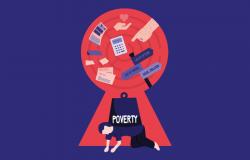At this Rate, It Will Take 200 Years to End Global Poverty

During the debate about global poverty that erupted earlier this year, one fact kept getting repeated: maybe poor people’s incomes haven’t increased enough to lift them out of actual poverty (grudgingly admitted), but at least they’ve been rising. For those who seek to defend neoliberal globalization, this fact has become a precious touchstone.
While it is true that the average incomes of poor people have increased since 1981, there are two crucial caveats to this that we need to pay attention to.
1) First, the increase has not been steady. Indeed, there have been long periods over the past few decades where the average incomes of the global poor (those living on less than $7.40 per day, the minimum necessary for decent nutrition and normal life expectancy) didn’t rise at all, and quite often actually fell. Here are a few examples:
-
In Latin America and the Caribbean, the average income of the poor fell after 1981 and didn’t recover its previous level until two decades later.
-
In the Middle East and North Africa, the average income of the poor fell after 1990 and didn’t recover its previous level until a decade later.
-
In South Asia, the average income of the poor fell after 1996 and didn’t recover until 2008.
-
And in Sub-Saharan Africa the average income of the poor declined after 1981 and didn’t recover until more than two decades later, in 2005.
Crucially, these periods of decline and stagnation happened almost entirely during the 1980s and 1990s, as neoliberal structural adjustment programs were imposed across the global South. In other words, the imposition of Washington Consensus capitalism during this period not only caused the number and percentage of poor people to rise (as I have described elsewhere), it also caused the incomes of the poor to decline and stagnate.
2) Second, the increase that has happened has been at an astonishingly slow pace. Since 1981 poor people’s daily incomes have increased by only about 2 cents per year, on average.
At this rate it will take around 200 years to end global poverty at $7.40 per day, and 500 years to end poverty at the US poverty line of $15 per day.

The graph above is based on World Bank poverty data. I’ve calculated the total poverty gap per region per year (i.e., the amount of additional income it would take to bring everyone above the poverty line of $7.40 per day), divided this by the number of poor people in each year to get the average distance that poor people live below the poverty line, and then subtracted this from $7.40 to show average income.
Keep in mind that this figure counts not only income but also consumption. So if a person is living on $2 per day, that includes not only the cash they might earn from wages, but also the value of food they grow themselves, and anything they might scavenge or receive as gifts for household consumption. And all of this is valued in terms of purchasing power in the United States. So $2 is what that amount of money would buy in the US in 2011; barely anything, basically. Not even enough to cover basic food needs.
What is more, these results overstate the incomes of the poor because the World Bank’s methodology doesn’t account for the fact that poor people spend a disproportionate amount of their income on food.
Here’s what the World Bank data reveals:

And remember: these are the people who render the majority of the resources and labour that keep the global economy going. What they get in return for that is literally pennies.
Those like Gates and Pinker who so adamantly defend the status quo of the global economy – this is what they are defending. That the incomes of the poor should grow by 2 cents per year, ensuring that poverty will be with us for hundreds of years to come.
This is a striking position to take, when you consider that poverty could be ended right now, forever, simply by shifting $6 trillion of existing global income to the poorest 60% of humanity. This would be enough to lift every human on the planet above the $7.40 line.
For perspective, the richest 1% capture more than $18 trillion each year in income, according to the World Inequality Database. In other words, we could tax the 1% a mere third of their income to put an end global poverty, and still leave them with an average income of $175,000 per year.
This is just a thought experiment, of course; to me a better approach is to change the rules of the global economy so that the world’s majority can claim a fairer share of the yields they produce in the first place, as I argue in The Divide. But the point is clear: global poverty today isn’t natural or inevitable, it is an artifact of the very same policies that have been designed to siphon the lion’s share of global income into the pockets of the rich.
This post first appeared on Jason's blog and was reposted with permission.
Image credit: Uri Baruchin via Flickr (CC BY 2.0)


